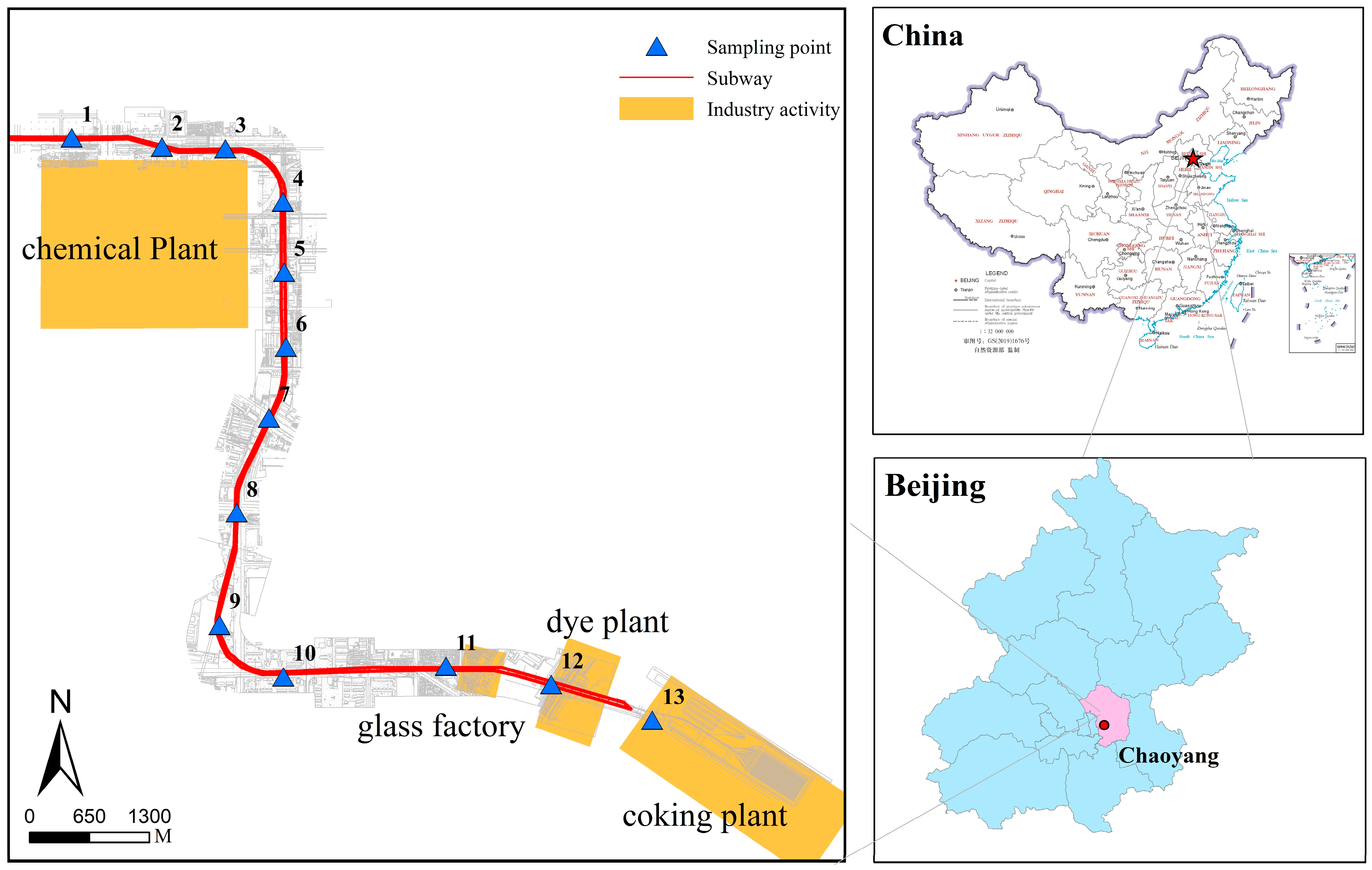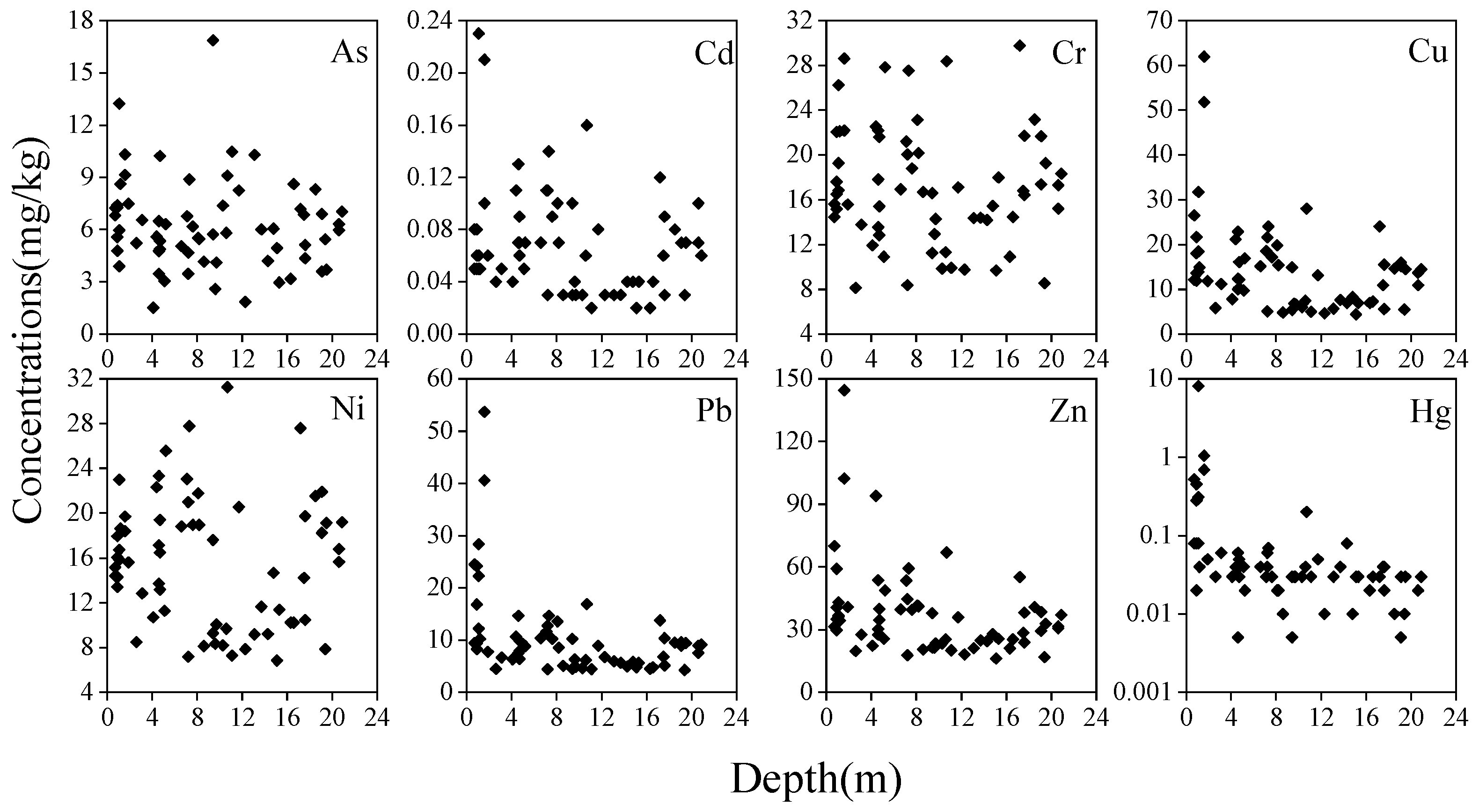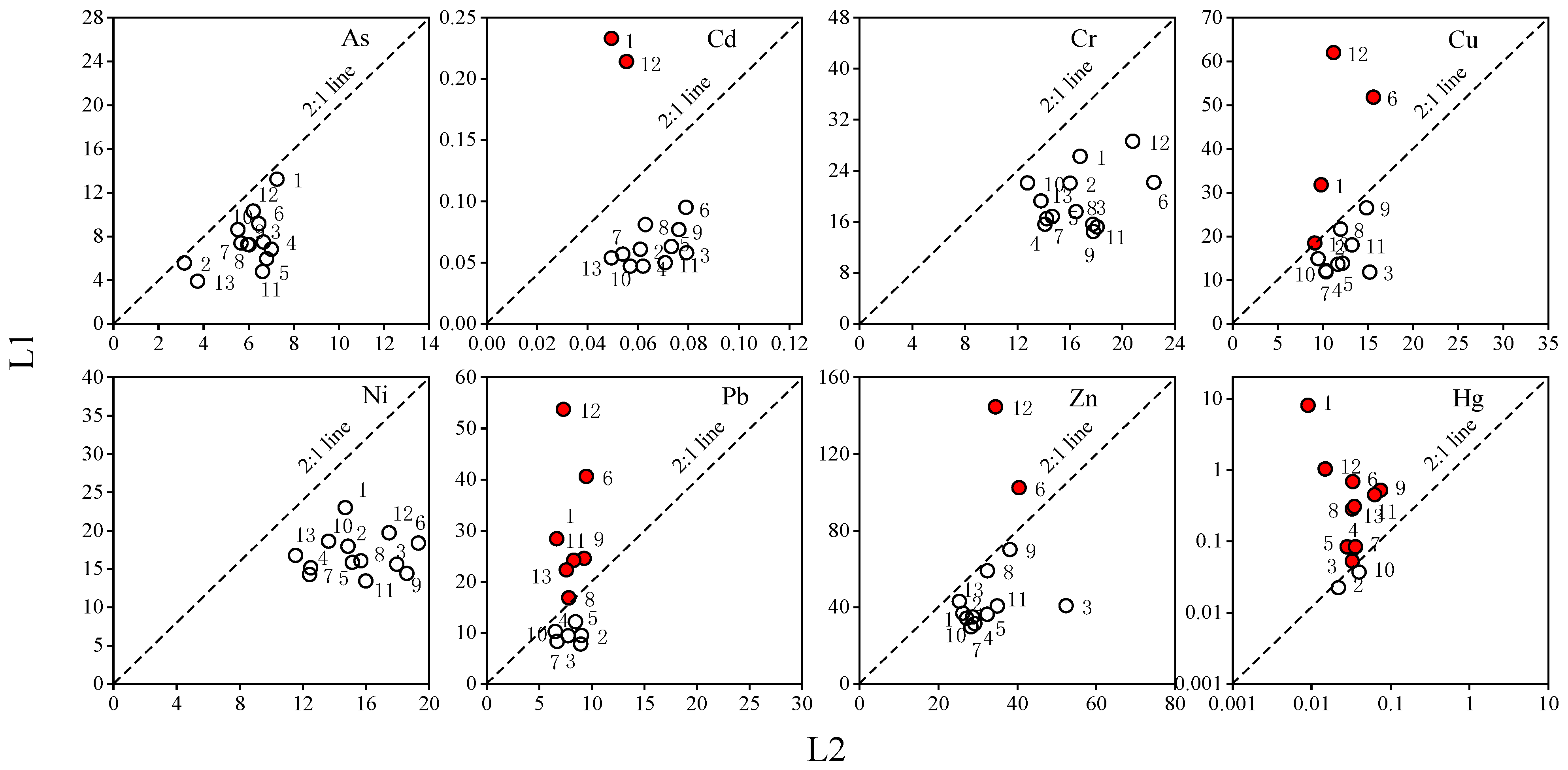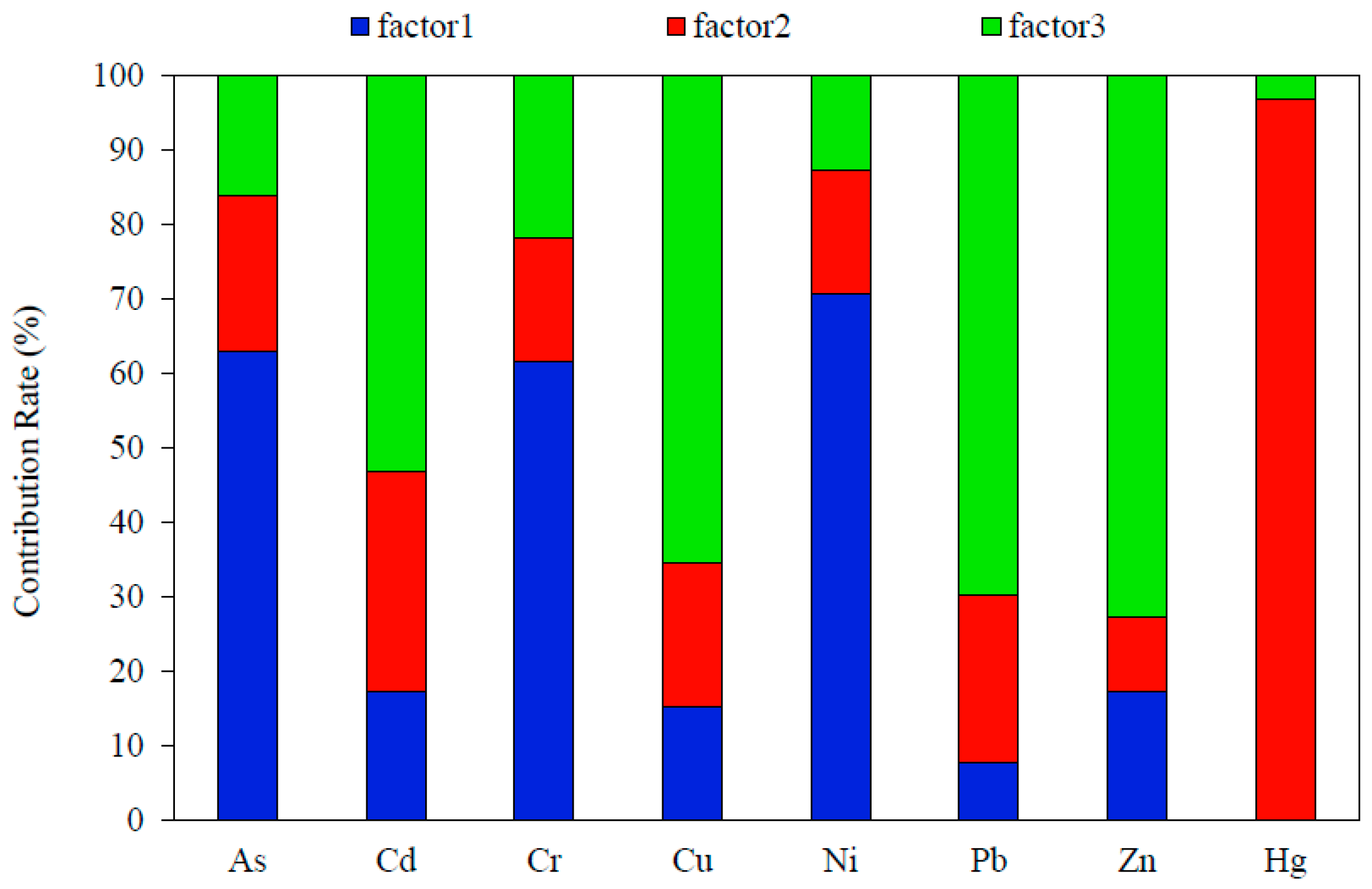Source Apportionment of Heavy Metals Based on Multiple Approaches for a Proposed Subway Line in the Southeast Industrial District of Beijing, China
Abstract
1. Introduction
2. Materials and Methods
2.1. Study Area and Sample Collection
2.2. Sample Preparation and Analysis
2.3. Top Enrichment Factor
2.4. Principal Component Analysis
2.5. Positive Matrix Factorization Method
3. Results
3.1. Descriptive Statistics Analysis
3.2. Distribution Characteristics
3.3. Source Apportionment
3.3.1. Correlation Analysis
3.3.2. Top Enrichment Factor Analysis
3.3.3. Principal Component Analysis
3.3.4. Positive Matrix Factorization
3.3.5. Comparison of Multiple Approaches
4. Conclusions
Author Contributions
Funding
Institutional Review Board Statement
Informed Consent Statement
Data Availability Statement
Conflicts of Interest
Appendix A
| As | Cd | Cr | Cu | Ni | Pb | Zn | Hg | |
|---|---|---|---|---|---|---|---|---|
| Min | 0.72 | 0.71 | 0.81 | 0.78 | 0.77 | 0.87 | 0.78 | 0.92 |
| Max | 1.82 | 4.71 | 1.73 | 5.54 | 1.56 | 7.34 | 4.19 | 905.5 |
| Mean | 1.28 | 1.47 | 1.19 | 2.00 | 1.12 | 2.61 | 1.63 | 79.91 |
| >2 | 0 | 15.4% | 0 | 30.8% | 0 | 53.8% | 15.4% | 76.9% |
| Element | Initial Eigenvalues | Extraction Sums of Squared Loadings | Rotation Sums of Squared Loadings | ||||||
|---|---|---|---|---|---|---|---|---|---|
| Total | % of Variance | Cumulative % | Total | % of Variance | Cumulative % | Total | % of Variance | Cumulative % | |
| As | 6.26 | 62.64 | 62.64 | 6.26 | 62.64 | 62.64 | 4.42 | 44.22 | 44.22 |
| Cd | 0.98 | 9.79 | 92.07 | 1.96 | 19.65 | 82.28 | 3.81 | 38.06 | 82.29 |
| Cr | 0.47 | 4.68 | 96.75 | ||||||
| Cu | 0.17 | 1.67 | 98.41 | ||||||
| Ni | 0.094 | 0.94 | 99.36 | ||||||
| Pb | 0.054 | 0.54 | 99.89 | ||||||
| Zn | 0.0026 | 0.026 | 99.99 | ||||||
| Hg | 0.0012 | 0.012 | 100.00 | ||||||
| Element | Component Matrix | Rotated Component Matrix | ||
|---|---|---|---|---|
| F1 | F2 | F1 | F2 | |
| As | 0.435 | 0.476 | 0.183 | 0.112 |
| Cd | 0.913 | 0.121 | 0.606 | 0.548 |
| Cr | 0.899 | −0.323 | 0.902 | 0.334 |
| Cu | 0.917 | 0.167 | 0.418 | 0.871 |
| Ni | 0.843 | −0.421 | 0.93 | 0.255 |
| Pb | 0.808 | 0.346 | 0.199 | 0.918 |
| Zn | 0.843 | 0.039 | 0.398 | 0.87 |
| Hg | 0.42 | 0.667 | 0.049 | 0.174 |
References
- Cheng, H.X.; Li, M.; Zhao, C.D.; Li, K.; Peng, M.; Qin, A.H.; Cheng, X.M. Overview of trace metals in the urban soil of 31 metropolises in China. J. Geochem. Explor. 2014, 139, 31–52. [Google Scholar] [CrossRef]
- Yang, Q.Q.; Li, Z.Y.; Lu, X.N.; Duan, Q.N.; Huang, L.; Bi, J. A review of soil heavy metal pollution from industrial and agricultural regions in China: Pollution and risk assessment. Sci. Total Environ. 2018, 642, 690–700. [Google Scholar] [CrossRef] [PubMed]
- Wang, S.; Cai, L.M.; Wen, H.H.; Luo, J.; Wang, Q.S.; Liu, X. Spatial distribution and source apportionment of heavy metals in soil from a typical county-level city of Guangdong Province, China. Sci. Total Environ. 2019, 655, 92–101. [Google Scholar] [CrossRef] [PubMed]
- Cai, L.M.; Wang, Q.S.; Luo, J.; Chen, L.G.; Zhu, R.L.; Wang, S.; Tang, C.H. Heavy metal contamination and health risk assessment for children near a large Cu-smelter in central China. Sci. Total Environ. 2019, 650, 725–733. [Google Scholar] [CrossRef]
- Xiao, Q.; Zong, Y.T.; Lu, S.G. Assessment of heavy metal pollution and human health risk in urban soils of steel industrial city (Anshan), Liaoning, Northeast China. Ecotoxicol. Environ. Saf. 2015, 120, 377–385. [Google Scholar] [CrossRef]
- Zhang, Y.M.; Chen, J.; Wang, L.Q.; Zhao, Y.L.; Qu, P.; Shi, W.L. Establishing a health risk assessment for metal speciation in soil-A case study in an industrial area in China. Ecotoxicol. Environ. Saf. 2018, 166, 488–497. [Google Scholar] [CrossRef]
- Sun, L.; Guo, D.K.; Liu, K.; Meng, H.; Zheng, Y.J.; Yuan, F.Q.; Zhu, G.H. Levels, sources, and spatial distribution of heavy metals in soils from a typical coal industrial city of Tangshan, China. CATENA 2019, 175, 101–109. [Google Scholar] [CrossRef]
- NPC. Law of the People’s Republic of China on Prevention and Control of Soil Pollution. In Proceedings of the Fifth Meeting of the Standing Committee of the 13th National People’s Congress, National People’s Congress of the People’s Republic of China, Beijing, China, 31 August 2018. [Google Scholar]
- Dong, B.; Zhang, R.Z.; Gan, Y.D.; Cai, L.Q.; Freidenreich, A.; Wang, K.P.; Guo, T.W.; Wang, H.B. Multiple methods for the identification of heavy metal sources in cropland soils from a resource-based region. Sci. Total Environ. 2019, 651, 3127–3313. [Google Scholar] [CrossRef]
- Lv, J.S. Multivariate receptor models and robust geostatistics to estimate source apportionment of heavy metals in soils. Environ. Pollut. 2019, 244, 72–83. [Google Scholar] [CrossRef]
- Shen, F.; Liao, R.M.; Ali, A.; Mahar, A.; Guo, D.; Li, R.H.; Sun, X.N.; Awasthi, M.K.; Wang, Q.; Zhang, Z.Q. Spatial distribution and risk assessment of heavy metals in soil near a Pb/Zn smelter in Feng County, China. Ecotoxicol. Environ. Saf. 2017, 139, 254–262. [Google Scholar] [CrossRef]
- Cai, L.M.; Xu, Z.C.; Ren, M.Z. Source identification of eight hazardous heavy metals in agricultural soils of Huizhou, Guangdong Province, China. Ecotoxicol. Environ. Saf. 2012, 72, 2–8. [Google Scholar] [CrossRef] [PubMed]
- Facchinelli, A.; Sacchi, E.; Mallen, L. Multivariate statistical and GIS-based approach to identify heavy metal sources in soils. Environ. Pollut. 2001, 114, 313–324. [Google Scholar] [CrossRef] [PubMed]
- Luo, X.S.; Xue, Y.; Wang, Y.L.; Cang, L.; Xu, B.; Ding, J. Source identification and apportionment of heavy metals in urban soil profiles. Chemosphere 2015, 127, 152–157. [Google Scholar] [CrossRef] [PubMed]
- Tian, Y.Z.; Wang, X.N.; Zhao, P.; Shi, Z.B.; Harrison, R.M. PM2.5 source apportionment using organic marker-based chemical mass balance modeling: Influence of inorganic markers and sensitivity to ource profiles. Atmos. Environ. 2023, 294, 119477. [Google Scholar] [CrossRef]
- Cheng, N.; Zhang, C.; Jing, D.; Li, W.; Guo, T.; Wang, Q.; Li, S. An integrated chemical mass balance and source emission inventory model for the source apportionment of PM2.5 in typical coastal areas. J. Environ. Sci. 2020, 92, 118–128. [Google Scholar] [CrossRef]
- Abdullahi, K.; Delgado-Saborit, J.; Harrison, R.M. Sensitivity of a Chemical Mass Balance model for PM2.5 to source profiles for differing styles. of cooking. Atmos. Environ. 2018, 178, 282–285. [Google Scholar] [CrossRef]
- Guan, Q.; Wang, F.; Xu, C.; Pan, N.; Lin, J.; Zhao, R.; Yang, Y.; Luo, H. Source apportionment of heavy metals in agricultural soil based on PMF: A case study in Hexi Corridor, northwest China. Chemosphere 2018, 193, 189–197. [Google Scholar] [CrossRef]
- Wu, J.; Li, J.; Teng, Y.; Chen, H.; Wang, Y. A partition computing-based positive matrix factorization (PC-PMF) approach for the source apportionment of agricultural soil heavy metal contents and associated health risks. J. Hazard. Mater. 2020, 388, 121766. [Google Scholar] [CrossRef]
- Liu, J.; Liu, Y.J.; Liu, Y.; Liu, Z.; Zhang, A.N. Quantitative contributions of the major sources of heavy metals in soils to ecosystem and human health risks: A case study of Yulin, China. Ecotoxicol. Environ. Saf. 2018, 164, 261–269. [Google Scholar] [CrossRef]
- Jin, G.; Fang, W.; Shafi, M.; Wu, D.; Li, Y.; Zhong, B.; Ma, J.; Liu, D. Source apportionment of heavy metals in farmland soil with application of APCS-MLR model: A pilot study for restoration of farmland in Shaoxing City Zhejiang, China. Ecotoxicol. Environ. Saf. 2019, 184, 109495. [Google Scholar] [CrossRef]
- Zhang, H.; Cheng, S.; Li, H.; Fu, K.; Xu, Y. Groundwater pollution source identification and apportionment using PMF and PCA-APCA-MLR receptor models in a typical mixed land-use area in Southwestern China. Sci. Total Environ. 2020, 741, 140383. [Google Scholar] [CrossRef] [PubMed]
- Li, Y.; Zhou, S.; Liu, K.; Wang, G.; Wang, J. Application of APCA-MLR receptor model for source apportionment of char and soot in sediments. Sci. Total Environ. 2020, 746, 141165. [Google Scholar] [CrossRef] [PubMed]
- Zuo, Q.; Duan, Y.H.; Yang, Y.; Wang, X.J.; Tao, S. Source apportionment of polycyclic aromatic hydrocarbons in surface soil in Tianjin, China. Environ. Pollut. 2007, 147, 303–310. [Google Scholar] [CrossRef] [PubMed]
- Liu, L.L.; An, Y.F.; Ma, J.; Chen, Y.X.; Wu, Y.H.; Li, J.Y.; Huang, J.X. Source Apportionment of Soil Heavy Metals in Beijing Urban Park Based on the UNMIX Model. Res. Environ. Sci. 2020, 33, 2856–2863. [Google Scholar] [CrossRef]
- Zhang, B.L.; Liu, L.L.; Huang, Z.B.; Hou, H. Source Apportionment of Soil Heavy Metal(loid)s in High Geochemical Background Area Based on the UNMIX Model. Res. Environ. Sci. 2022, 1–13. [Google Scholar] [CrossRef]
- Chen, Z.; Ding, Y.; Jiang, X.; Duan, H.; Ruan, X.; Li, Z.; Li, Y. Combination of UNMIX, PMF model and Pb-Zn-Cu isotopic compositions for quantitative source apportionment of heavy metals in suburban agricultural soils. Ecotoxicol. Environ. Saf. 2022, 234, 113369. [Google Scholar] [CrossRef]
- Liao, S.Y.; Jin, G.Q.; Khan, M.A.; Zhu, Y.W.; Duan, L.L.; Luo, W.X.; Jia, J.W.; Zhong, B.; Ma, J.W.; Ye, Z.Q.; et al. The quantitative source apportionment of heavy metals in peri-urban agricultural soils with UNMIX and input fluxes analysis. Environ. Technol. Innov. 2021, 21, 101232. [Google Scholar] [CrossRef]
- Guan, Q.Y.; Zhao, R.; Pan, N.H.; Wang, F.F.; Yang, Y.Y.; Luo, H.P. Source apportionment of heavy metals in farmland soil of Wuwei, China: Comparison of three receptor models. J. Clean. Prod. 2019, 237, 117792. [Google Scholar] [CrossRef]
- Henry, R.C. History and fundamentals of multivariate air quality receptor models. Chemom. Intell. Lab. Syst. 1997, 37, 37–42. [Google Scholar] [CrossRef]
- Norris, G.; Duvall, R.; Brown, S.G.; Bai, S. EPA Positive Matrix Factorization (PMF) 5.0 Fundamentals and User Guide; U.S. EPA: Washington, DC, USA, 2014. [Google Scholar]
- Wang, Y.; Li, Y.; Yang, S.Y.; Liu, J.; Zheng, W.; Xu, J.M.; Cai, H.M.; Liu, X.M. Source apportionment of soil heavy metals: A new quantitative framework coupling receptor model and stable isotopic ratios. Environ. Pollut. 2022, 314, 120291. [Google Scholar] [CrossRef]
- Zhou, L.; Liu, G.; Shen, M.; Hu, R.; Liu, Y. Source identification of heavy metals and stable carbon isotope in indoor dust from different functional areas in Hefei, China. Sci. Total Environ. 2020, 710, 135599. [Google Scholar] [CrossRef]
- Sun, G.X.; Wang, X.J.; Hu, Q.H. Using stable lead isotopes to trace heavy metal contamination sources in sediments of Xiangjiang and Lishui Rivers in China. Environ. Pollut. 2011, 159, 3406–3410. [Google Scholar] [CrossRef] [PubMed]
- Sungur, A.; Soylak, M.; Özcan, H. Fractionation, Source Identification and Risk Assessments for Heavy Metals in Soils near a Small-Scale Industrial Area (Çanakkale-Turkey). Soil Sediment Contam. Int. J. 2019, 28, 213–227. [Google Scholar] [CrossRef]
- Sungur, A.; Soylak, M.; Özcan, H. Chemical fractionation, mobility and environmental impacts of heavy metals in greenhouse soils from Çanakkale, Turkey. Environ. Earth Sci. 2016, 75, 334. [Google Scholar] [CrossRef]
- Li, X.G.; Li, J.; Sui, H.; Cao, X.T.; Li, Y.H. Evaluation and determination of soil remediation schemes using a modified AHP model and its application in a contaminated coking plant. J. Hazard. Mater. 2018, 353, 300–311. [Google Scholar] [CrossRef]
- Xia, T.X.; Jiang, L.; Jia, X.Y.; Zhong, M.S. Application of probabilistic risk assessment at a coking plant site contaminated by polycyclic aromatic hydrocarbons. Front. Environ. Sci. Eng. 2014, 8, 441–450. [Google Scholar] [CrossRef]
- Reff, A.; Eberly, S.I.; Bhave, P.V. Receptor Modeling of Ambient Particulate Matter Data Using Positive Matrix Factorization: Review of Existing Methods. J. Air Waste Manag. Assoc. 2007, 57, 146–154. [Google Scholar] [CrossRef]
- Accornero, M.; Jiang, L.; Napoli, E.; Cremoini, M.; Ferro, G.; Belloro, F.; Zhong, M.S. Probability distributions of arsenic in soil from brownfield sites in Beijing (China): Statistical characterization of the background populations and implications for site assessment studies. Front. Environ. Sci. Eng. 2015, 9, 465–474. [Google Scholar] [CrossRef]
- Xia, X.H.; Zhang, Z.R.; Zhang, X.Y.; Tang, Z.Q.; Li, Y.Y.; Zou, B.D.; Jing, H.W.; Li, K.X.; Zhang, Q.; Liu, S.D. Implications of spatial and temporal variation characteristics of heavy metals in urban soil for the determination of soil heavy metal background values: A case study for Beijing. Acta Sci. Circumstantiae 2022, 1–10. [Google Scholar] [CrossRef]
- Micó, C.; Recatalá, L.; Peris, M.; Sánchez, J. Assessing heavy metal sources in agricultural soils of an European Mediterranean area by multivariate analysis. Chemosphere 2006, 65, 863–872. [Google Scholar] [CrossRef]
- Zhou, J.; Feng, K.; Li, J.; Zhou, Y. Factorial Kriging analysis and sources of heavy metals in soils of different land-use types in the Yangtze River Delta of Eastern China. Environ. Sci. Pollut. Res. 2016, 23, 14957–14967. [Google Scholar] [CrossRef] [PubMed]
- Mikkonen, H.G.; Dasika, R.; Drake, J.A.; Wallis, C.J.; Clarke, B.; Reichman, S.M. Evaluation of environmental and anthropogenic influences on ambient background metal and metalloid concentrations in soil. Sci. Total Environ. 2018, 624, 599–610. [Google Scholar] [CrossRef] [PubMed]
- Duan, X.C.; Yu, H.H.; Ye, T.R.; Huang, Y.; Li, J.; Yuan, G.L.; Albanese, S. Geostatistical mapping and quantitative source apportionment of potentially toxic elements in top- and sub-soils: A case of suburban area in Beijing, China. Ecol. Indic. 2020, 112, 106085. [Google Scholar] [CrossRef]
- Liu, Y. Geochemistry of Elements; Academic Press: Beijing, China, 1984. [Google Scholar]
- Yang, J.; Teng, Y.G.; Wu, J.; Chen, H.Y.; Wang, G.Q.; Song, L.T.; Yue, W.F.; Zuo, R.; Zhai, Y.Z. Current status and associated human health risk of vanadium in soil in China. Chemosphere 2017, 171, 635–643. [Google Scholar] [CrossRef]
- Xue, J.L.; Zhi, Y.Y.; Yang, L.P.; Shi, J.C.; Zeng, L.Z.; Wu, L.S. Positive matrix factorization as source apportionment of soil lead and cadmium around a battery plant (Changxing County, China). Environ. Sci. Pollut. Res. 2014, 21, 7698–7707. [Google Scholar] [CrossRef]
- Lu, J.S. Source apportionment and spatial prediction of heavy metals in soils of Yantai coastal zone. Acta Geogr. Sin. 2021, 76, 713–725. [Google Scholar] [CrossRef]
- Wang, C.; Yang, Z.; Zhong, C.; Ji, J. Temporal-spatial variation and source apportionment of soil heavy metals in the representative river-alluviation depositional system. Environ. Pollut. 2016, 216, 18–26. [Google Scholar] [CrossRef]
- AMAP; UNEP. Technical Background Report for the Global Mercury Assessment 2013; Arctic Monitoring and Assessment Programme: Oslo, Norway; UNEP ChemicalsBranch: Geneva, Switzerland, 2013. [Google Scholar]
- Xu, J.Y.; Bravo, A.G.; Lagerkvist, A.; Bertilsson, S.; Sjöblom, R.; Kumpiene, J. Sources and remediation techniques for mercury contaminated soil. Environ. Int. 2015, 74, 42–53. [Google Scholar] [CrossRef]
- Sun, X.F.; Zhang, L.X.; Dong, Y.L.; Zhu, L.Y.; Wang, Z.; Lv, J.S. Source Apportionment and Spatial Distribution Simulation of Heavy Metals in a Typical Petrochemical Industrial City. Environ. Sci. 2021, 42, 1093–1104. [Google Scholar] [CrossRef]
- Dong, Y.; Sun, L.; Li, H.T.; Zhang, Z.C.; Zhang, Y.; Li, G.; Guo, X.B. Sources and spatial distribution of heavy metals and arsenic in soils from Xiong’an New District, China. Hydrogeol. Eng. Geol. 2021, 48, 172–181. [Google Scholar] [CrossRef]
- Chen, X.; Xia, X.; Wu, S.; Wang, F.; Guo, X. Mercury in urban soils with various types of land use in Beijing, China. Environ. Pollut. 2010, 158, 48–54. [Google Scholar] [CrossRef] [PubMed]
- Wang, P. Investigation and Risk Assessment of Heavy Metals Pollution in Soil on Both Side of Some Roads in Beijing. Master’s Thesis, Beijing University of Civil Engineering and Architecture, Beijing, China, 2014. [Google Scholar]
- Zhang, K. Temporal and Spatial Distribution and Risk Assessment of Heavy Metal Pollution in Modern Coal Chemical Plant. Ph.D. Thesis, China University of Mining & Technology, Beijing, China, 2018. [Google Scholar]
- Pan, L.B.; Ma, J.; Wang, X.L.; Hou, H. Heavy metals in soils from a typical county in Shanxi Province, China: Levels, sources and spatial distribution. Chemosphere 2016, 148, 248–254. [Google Scholar] [CrossRef] [PubMed]
- van Bohemen, H.D.; van de Laak, W.H.J. The Influence of Road Infrastructure and Traffic on Soil, Water, and Air Quality. Environ. Manag. 2003, 31, 50–68. [Google Scholar] [CrossRef] [PubMed]
- Zhang, J.; Pei, H.; Kreb, P. The chemical fractionation and potential source identification of Cu, Zn and Cd on urban watershed. Water Sci. Technol. 2015, 72, 1428–1436. [Google Scholar] [CrossRef] [PubMed]
- Ozaki, H.; Watanabe, I.; Kuno, K. Investigation of the Heavy Metal Sources in Relation to Automobiles. Water Air Soil Pollut. 2004, 157, 209–223. [Google Scholar] [CrossRef]
- Zhang, X.W.; Yan, Y.; Wadood, S.A.; Sun, Q.Q.; Guo, B.L. Source apportionment of cadmium pollution in agricultural soil based on cadmium isotope ratio analysis. Appl. Geochem. 2020, 123, 104776. [Google Scholar] [CrossRef]






| Elements | As | Cd | Cr | Cu | Ni | Pb | Zn | Hg | |
|---|---|---|---|---|---|---|---|---|---|
| Method Detective Level | 0.50 | 0.01 | 0.10 | 0.10 | 0.10 | 0.10 | 0.50 | 0.01 | |
| Topsoil (n = 13) | Min | 3.89 | 0.050 | 14.45 | 11.86 | 13.42 | 7.79 | 29.78 | 0.020 |
| Max | 13.24 | 0.23 | 28.61 | 61.99 | 22.98 | 53.72 | 144.54 | 8.13 | |
| Mean | 7.52 | 0.090 | 19.40 | 23.74 | 16.86 | 20.60 | 54.16 | 0.91 | |
| SD | 2.45 | 0.060 | 4.50 | 16.02 | 2.63 | 13.98 | 33.84 | 2.19 | |
| CV | 0.33 | 0.71 | 0.23 | 0.67 | 0.16 | 0.68 | 0.62 | 2.42 | |
| Background value | 9.70 | 0.07 | 68.10 | 23.60 | 29.00 | 25.40 | 102.60 | 0.070 | |
| Samples exceeding background value | 15.38% | 38.46% | - | 30.77% | - | 23.08% | 7.69% | 76.92% | |
| Maximum exceedance as a multiple of background level | 0.36 | 2.15 | - | 1.63 | - | 1.12 | 0.41 | 116.88 | |
| Subsoil (n = 51) | Min | 1.53 | 0.020 | 8.14 | 4.36 | 6.84 | 4.26 | 16.17 | 0.010 |
| Max | 16.86 | 0.16 | 29.75 | 27.99 | 31.24 | 16.90 | 94.02 | 0.20 | |
| Mean | 5.94 | 0.060 | 16.66 | 11.98 | 15.41 | 8.03 | 33.19 | 0.040 | |
| SD | 2.60 | 0.030 | 5.40 | 6.07 | 6.30 | 3.15 | 14.62 | 0.030 | |
| CV | 0.44 | 0.53 | 0.32 | 0.51 | 0.41 | 0.39 | 0.44 | 0.83 | |
| Background value | 9.70 | 0.070 | 68.10 | 23.60 | 29.00 | 25.40 | 102.60 | 0.070 | |
| Samples exceeding background value | 7.84% | 29.41% | - | 5.88% | - | - | - | 5.88% | |
| Maximum exceedance as a multiple of background level | 0.74 | 1.12 | - | 0.19 | - | - | - | 1.96 | |
| Element | As | Cd | Cr | Cu | Ni | Pb | Zn | Hg |
|---|---|---|---|---|---|---|---|---|
| As | 1.000 | 0.688 ** | 0.555 * | 0.390 | 0.577 * | 0.302 | 0.220 | 0.370 |
| Cd | 0.688 ** | 1.000 | 0.461 | 0.637 * | 0.475 | 0.580 * | 0.555 * | 0.623 * |
| Cr | 0.555 * | 0.461 | 1.000 | 0.538 | 0.940 ** | 0.462 | 0.198 | 0.276 |
| Cu | 0.390 | 0.637 * | 0.538 | 1.000 | 0.544 | 0.973 ** | 0.758 ** | 0.845 ** |
| Ni | 0.577 * | 0.475 | 0.940 ** | 0.544 | 1.000 | 0.451 | 0.264 | 0.243 |
| Pb | 0.302 | 0.580 * | 0.462 | 0.973 ** | 0.451 | 1.000 | 0.736 ** | 0.884 ** |
| Zn | 0.220 | 0.555 * | 0.198 | 0.758 ** | 0.264 | 0.736 ** | 1.000 | 0.652 * |
| Hg | 0.370 | 0.623 * | 0.276 | 0.845 ** | 0.243 | 0.884 ** | 0.652 * | 1.000 |
Disclaimer/Publisher’s Note: The statements, opinions and data contained in all publications are solely those of the individual author(s) and contributor(s) and not of MDPI and/or the editor(s). MDPI and/or the editor(s) disclaim responsibility for any injury to people or property resulting from any ideas, methods, instructions or products referred to in the content. |
© 2022 by the authors. Licensee MDPI, Basel, Switzerland. This article is an open access article distributed under the terms and conditions of the Creative Commons Attribution (CC BY) license (https://creativecommons.org/licenses/by/4.0/).
Share and Cite
Jia, X.; Xia, T.; Liang, J.; Li, Y.; Zhu, X.; Zhang, D.; Wang, J. Source Apportionment of Heavy Metals Based on Multiple Approaches for a Proposed Subway Line in the Southeast Industrial District of Beijing, China. Int. J. Environ. Res. Public Health 2023, 20, 683. https://doi.org/10.3390/ijerph20010683
Jia X, Xia T, Liang J, Li Y, Zhu X, Zhang D, Wang J. Source Apportionment of Heavy Metals Based on Multiple Approaches for a Proposed Subway Line in the Southeast Industrial District of Beijing, China. International Journal of Environmental Research and Public Health. 2023; 20(1):683. https://doi.org/10.3390/ijerph20010683
Chicago/Turabian StyleJia, Xiaoyang, Tianxiang Xia, Jing Liang, Yandan Li, Xiaoying Zhu, Dan Zhang, and Jinsheng Wang. 2023. "Source Apportionment of Heavy Metals Based on Multiple Approaches for a Proposed Subway Line in the Southeast Industrial District of Beijing, China" International Journal of Environmental Research and Public Health 20, no. 1: 683. https://doi.org/10.3390/ijerph20010683
APA StyleJia, X., Xia, T., Liang, J., Li, Y., Zhu, X., Zhang, D., & Wang, J. (2023). Source Apportionment of Heavy Metals Based on Multiple Approaches for a Proposed Subway Line in the Southeast Industrial District of Beijing, China. International Journal of Environmental Research and Public Health, 20(1), 683. https://doi.org/10.3390/ijerph20010683






